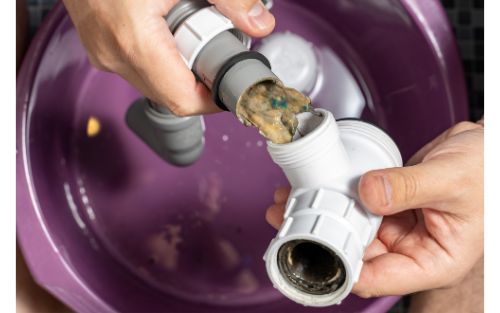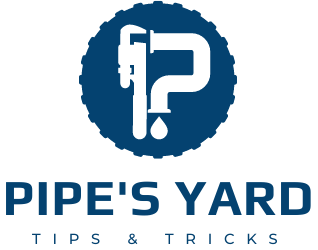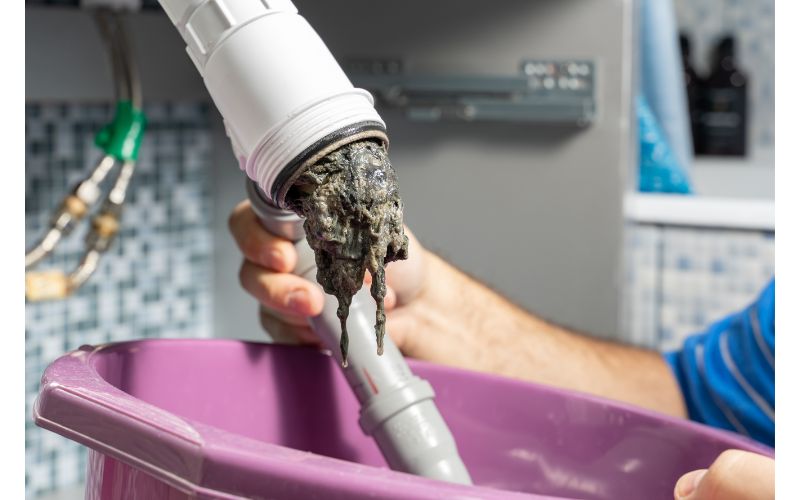A clogged sewer line is a nightmare that demands immediate action. With decades-long experience, we see many people become overwhelmed due to not knowing the unclogging process.
So, how to unclog a sewer pipeline? You can implement several methods to unclog a sewer pipeline. This includes; mechanical snaking, hydro jetting, flushing out with a chemical drain cleaner, etc.
Here, we detail all these methods while discussing every aspect of getting rid of the clogged sewer system. Let’s start.
How To Unclog A Sewer Pipe?
We have sorted the unclogging process into three sections, starting with signs of clogging and ending with unclogging.
1. Signs of Sewage Pipeline Blockage
If you sense a blockage in the sewer line, look for the signs below to be confirmed.
- If you notice that water is slowly draining from your sinks, showers, or toilets, consider it an early sign of a sewage pipeline blockage.
- Unusual gurgling or bubbling sounds coming from drainage systems or toilets.
- A strong and unpleasant smell originates from your drains, toilets, or the general vicinity of your sewage system.
- If wastewater starts to back up repeatedly from your drains, sinks, or toilets, it’s a definite sign of severe blockage.
- If multiple drains in your home are experiencing problems simultaneously.
2. Materials Required for Unclogging Task Conduction
So, now you are sure that your property’s sewer system is clogged, and you are going to address that. Arrange below-listed items.
- Waterproof work gloves: Essential for protecting your hands from potential contaminants while working on the sewer pipe.
- Waterproof shoes/boots: It’s advisable to wear waterproof footwear to keep your feet dry and protected from any potential water or sewage spills.
- Garden hose: Can be used for applying water pressure to help dislodge clogs or for the hydro jetting method.
- Plumbing snake/pipe auger: These tools are specifically designed to navigate through pipes and break up or remove clogs effectively.
- Plunger: A basic plunger helps create pressure to dislodge the clog and restore the flow in the sewer line.
- Cleaning agent: Depending on the unclogging method selection, you may also need drain-cleaning substances.
- Pipe wrench: Useful for tightening or loosening pipe fittings if necessary during unclogging.
- Rags or towels: Keep some rags or towels nearby to clean up any spills or wipe down the area after the unclogging process.

3. Unclogging a Sewer Pipe Line
In this section, we elaborate on each unclogging method. You should select one as per the blockage condition.
Method 1: Use of Hydro Jetting
This method is also known as the power washer method. To apply this method, follow the below-listed steps.
Step 1: Find the screw-on cap on the cleanout pipe. You can locate it in your basement or near the drainage line.
Step 2: Remove the cap.
Step 3: Place a container underneath to catch any wastewater or sewage that may spill out.
Step 4: Open the clear-out pipe.
Step 5: Connect a hydro jetter to the trigger gun.
Step 6: Carefully place the jetter into the clogged sewer line. Reach out to the collaged point.
Step 7: Turn on the power washer’s water, ensuring there is no flow back.
Step 8: Increase the water pressure slowly.
Step 9: Pull the jetter back and forth in the sewer line to clear the clog.
Step 10: The blockage will be gone.
Method 2: Using a Plunger
Using a plunger is a common and effective method to clean a clog. Here’s a step-by-step guide on how to use a plunger to clear a clog:
Step 1: Choose a plunger that is designed explicitly for sinks or toilets. Sink plungers have a flat, shallow cup, while toilet plungers have a larger, bell-shaped cup with an extended flange.
Step 2: Now, fill the sink or toilet with water. In the case of a bathroom, water is already in the bowl; there is no need for water addition.
Step 3: Place the plunger over the opening. This step is critical; you must ensure that the seal between the plunger cup and the surface around the drain is airtight.
Step 4: Press the plunger downward firmly, then quickly pull it back up. This action creates suction and pressure changes.
Step 5: Do this about 10-15 times.
Step 6: Check if the water is draining correctly. If not, re-apply the process.
Step 7: Finally, once the clog is cleared, clean the plunger thoroughly and sanitize it before storing it.
Method 3: Using Mechanical Snaking
Mechanical snaking is another reliable method for tackling stubborn or deep clogs in sewer lines. Here is how to apply this method.
Step 1: You can rent or purchase the plumber snake or auger tool from hardware stores. This tool is also available at local home improvement stores. Make sure to choose a suitable length for reaching the clog.
Step 2: Put on protective gloves and place a bucket or towel near the area to catch any debris or water that may come out during the unclogging process.
Step 3: Insert the snake into the sewer line through the access point to the sewer line. Make sure that the seal is tight. Insert the snake into the pipe until you feel resistance.
Step 4: Start turning the handle or crank on the snake to rotate the flexible cable. As you turn, carefully maneuver the snake back and forth to break apart or hook onto the clog.
Step 5: Make sure you apply steady pressure. This helps to dislodge the clog and push it further down the pipe or pull it out.
Step 6: Check the unclogging condition.
Step 7: Once you feel that the clog has been cleared, carefully withdraw the snake from the pipe. Clean the snake thoroughly and sanitize it before storing it.
Step 8: Dispose of any debris appropriately collected and clean the respective area.
Method 4: Using Hot Water or Cleaning Agent or Homemade Cleaning Substance
You can also use hot water, factory-made drain cleaning agents, or homemade cleaning agents to unclog the sewage line. For a homemade cleaning agent, mix 113 grams of baking soda and 113 grams of white vinegar, and mix it with water.
After selecting from these three, take the liquid into a jar and pour it at the opening. If you use hot water, it is better to use more than 1 or 2 cups.
To apply this method effectively with hot water, check out this YouTube video:
When to Use Which Method?
Below tables are meant to provide you with a brief overview of the criteria applicable to each method.
| Method | Applicability |
| Hydro jetting | Severe or recurring clogs, extensive blockages, or as part of routine maintenance for sewer lines |
| Plunging | Minor clogs or blockages caused by soft materials |
| Mechanical snaking | More stubborn or deeper clogs |
| Hot water or chemical | Minor clogging |
Tips to Prevent Sewer System Blockage
By implementing the listed preventive measures, you can reduce the risk of sewer system blockages while facilitating a proper functioning state.
- Avoid flushing non-biodegradable items such as paper towels, sanitary products, wipes, or diapers down the toilet.
- Do not pour grease, oil, or fat down the drains.
- Do scheduled maintenance of the sewer system.
- Avoid planting trees or large shrubs near your sewer lines.
- Dispose of food waste into the trash before washing dishes.
- Teach everyone in your household about proper drain usage and what should and should not be flushed or poured down the drains.
Frequently Asked Questions
Here, we answer some general questions regarding sewage system clogging.
Q: What is the cost of unclogging the sewer pipeline?
If you do it by yourself, it will only cost you the required materials. However, if you take professional help, be ready to pay $120-$150 per hour.
Q: Is there any chemical to unclog sewer lines effortlessly?
Yes. You can choose from Drano Drain Clog Remover, Drainsoon Drain Clog Remover, Instant Power Drain Clog Remover, etc. However, if the severity level of the blockage is high, these chemicals won’t bring any fruitful results.
Q: Can I use detergent to unblock the sewage pipeline?
No, using detergent to unblock a sewage pipeline is not recommended. Detergent is designed to break down grease and grime on surfaces, but it can also cause foaming and clogging in pipes.
Final Thoughts
Unclogging a sewer pipe requires effective methods and tools, such as using a power washer, a force-ball plunger, or a plumber’s snake. We expect that after reading the detailing on how to unclog a sewer pipe, you will be able to select the right approach and apply that effectively.
Remember that following the proper steps and precautions is crucial to ensure success and minimize potential damage or health hazards. However, prevention is always better than dealing with a clogged sewer line. And if you encounter a complex clog, we advise you to take professional assistance.

